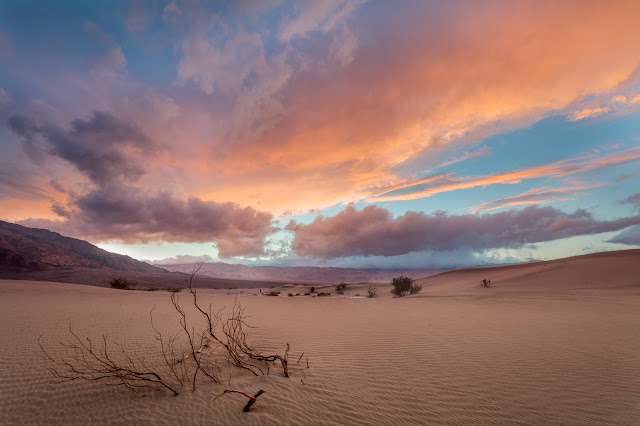The program was divided into the following five sections from most to least important:
- Light
- Subject
- Composition
- Techniques
- Gear
Note that gear is listed last. In my opinion, a high-quality professional camera, lens, and accessories in the hands of someone who doesn't understand the first four points may be a waste of money. A skilled photographer can make quality photos with a variety of gear. Some professionals even make and sell photos with their cell phone! Don't get me wrong - quality camera gear is important, but it is more important to focus on the first four points.
All you really have to have to make great landscape photos is:
- A camera or lens that lets you shoot wide angles. I like something that starts around 17mm on a full frame camera or 13mm on a cropped sensor camera.
- A camera or lens that lets you zoom in and isolate a subject. A lens that lets you zoom out to somewhere between 200mm and 300mm (full frame equivalent) will meet most of your needs.
- A tripod. See my earlier post on tripods.
You will find lenses with focal lengths between the wide angle and telephoto useful. There are a number of other accessories that are useful, but not required. I'll post about those another day. To quote Forest Gump - That's all I'm going to say about that! (for now).
In my experience, light is the most important factor that goes into making great landscape photos. Unlike photographers who work primarily indoors, a landscape photographer can't control the light. What we can control is when and where we make our photos.
In my experience, light is the most important factor that goes into making great landscape photos. Unlike photographers who work primarily indoors, a landscape photographer can't control the light. What we can control is when and where we make our photos.
- Time of day and direction of sunlight
- Season
- Cloudy or clear skies
- Wind
Each of these four factors impact the quality of landscape photos.
Best Time of Day
 |
| Golden Hour |
The best time of day for landscape photography is the golden hour - the hours after sunrise and before sunset. At this time of day, the sunlight will be soft, warm and low. Add some clouds and the golden hour can also be very dramatic. In the photo above, the sun was behind me and lighting up the clouds with a warm orange color. The orange clouds also provided some nice color contrast with the blue sky. This warm cloud color reflected down on the sand, making it appear warmer. The low angle of the sunlight also emphasized the ripples in the sand adding an interesting foreground element.
Now imagine if you will what this photo would have looked like around mid-day. The sun would have been high overhead and the ripples in the sand would have been almost impossible to see in the photo. Here's a photo made nearby in the early afternoon.
 |
| Mid-day |
Because the angle of the sunlight is high it's difficult to discern the layers in the dunes and mountains. This makes the photo appear flat and less interesting. The color does not have that warm pleasing look like the previous photo. The second photo does have a desolate feel to it. If your shooting a cover for "A Horse With No Name" this may be exactly the right photo to tell that story.
Below is a great example of how the quality of the mid-day and late afternoon sunlight can make all the difference in a photo. The photo on the left was taken at mid-day when the sun was shining down on a creek in a small canyon in Glacier National Park. The light is direct and harsh and the highlights are too bright. The second photo was taken a few hours later on the same day. The light in the second photo was indirect, soft and the tonality is balanced. A few hours makes the difference between a photo destined for the bit bucket and a keeper.
Besides the golden hour light, there is another reason to shoot around sunrise and sunset. Those are the times when the wind is typically the calmest. If you want to make a photo with a mirror like reflection in a water surface or no movement in vegetation you should try to be there around sunrise. The early morning winds will usually be calmer than those around sunset.
 |
| Early Morning Reflections |
Don't pack up and leave after the sun sets. Just before the morning golden hour and after the evening golden hour is what's called the blue hour when the sun is significantly below the horizon. During the blue hour, the sky will take on a beautiful blue shade.
 |
| Blue Hour |
As landscape photographers, we can't control the light, but we can control when we make our photographs. This may involve getting up hours before sunrise and staying out hours after sunset. The middle of the day is reserved for taking naps!
The material in my presentation to the Eastman Camera Club and this post come from my Basic Photography Class. The class is four two-hour sessions plus a local field trip to practice. I will be scheduling another class later this year after summer vacation times. If you would like to be notified when the class is scheduled, send a note to rcsiggins@gmail.com.

















